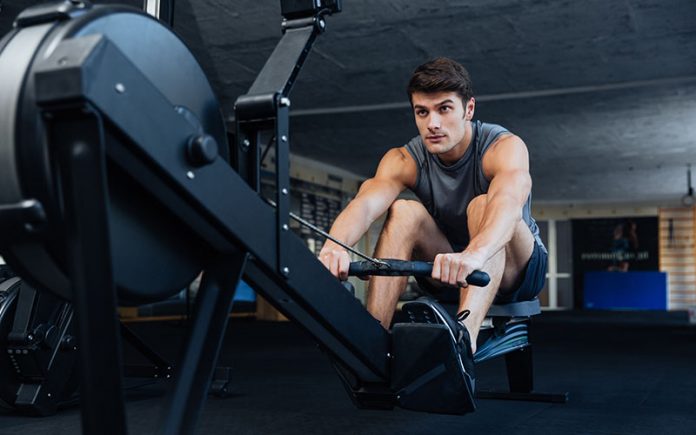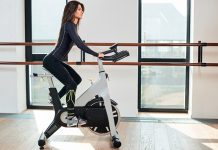Exercising regularly is essential for good health. Exercise should be a part of everyone’s weekly routine, that way you will always stay in great shape. It will improve your endurance and strength, whilst helping you look super buff! If you want to lose weight, gain muscle, train for a race, or achieve something specific, then your fitness routine should be specifically tailored to that goal. Whether you are exercising to keep fit or aiming to reach an ambitious goal, including cardio is vitally important.
A cardio workout is essentially any form of exercise that raises your heart rate. It could be running, swimming, cycling or something else, but these three are by far the best forms of cardio exercise you can do. There are so many benefits to doing cardio. They help you lose weight, reduce stress, improve the strength of your heart and lungs, and also help develop your stamina.
Although swimming, cycling, and running are the best forms of cardio, not everyone has the time to get out of the house, so many people choose to exercise at home and buy a machine to workout on. There are many different machines you can choose from. You can buy ellipticals, exercise bikes that are both upright and recumbent, and treadmills. However, buying a top-rated rowing machine is a great choice, but it is often overlooked. It is an excellent machine because it trains both the upper and lower body, giving you a great all-over cardio workout.
Why Choose to Buy a Rowing Machine over Other Gym Equipment?
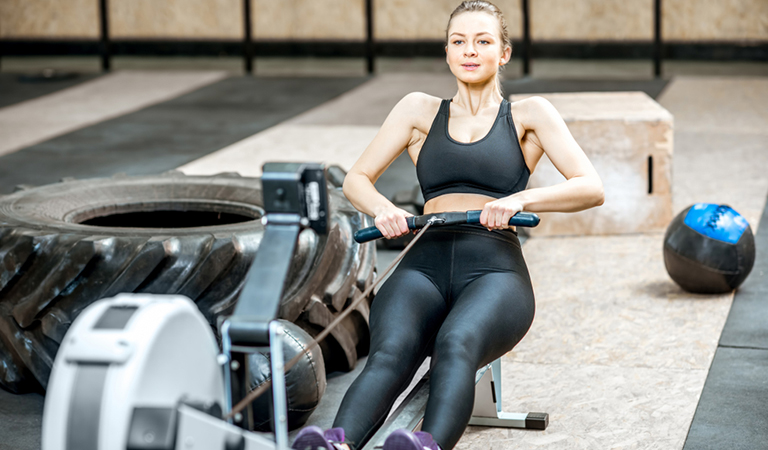
Rowing machines aren’t always the most popular choice of gym equipment. If you are thinking about investing in some home exercise equipment, most people will probably think of an exercise bike, elliptical or treadmill first. They are all a similar size, and we use these the most at the gym. But a rowing machine is actually a really brilliant investment, and shouldn’t be overlooked so much.
First of all, it works your whole body. A treadmill, for example, will only give your lower body a great cardio workout. Admittedly it will probably give you a better lower body workout than a rowing machine, but it still only works your leg muscles. The same is true of the exercise bike. It only works your lower body, in a low-impact way. Elliptical trainers are another popular choice and unlike treadmills, they do work your upper and lower body. However, a rowing machine is much better at strengthening your core and building up your ab muscles. Generally, people also choose an easier workout on an elliptical, so you will burn less calories and not have as strong a cardio workout as you would on a rowing machine.
A rowing machine gives you that whole body cardio workout, that the other pieces of equipment can’t give. It enables you to have a nice low-impact workout whilst really pushing your lower and upper body. If you have been thinking about what rowing machine uses what muscles, then they actually all build muscle all over, whilst also strengthening your core and working your entire body, all in one. They help you to train different muscle groups easily, and are a great machine to get your heart pumping. With this machine, you will work all rowing machine muscle groups.
The Basic Techniques of a Great Rowing Machine Workout
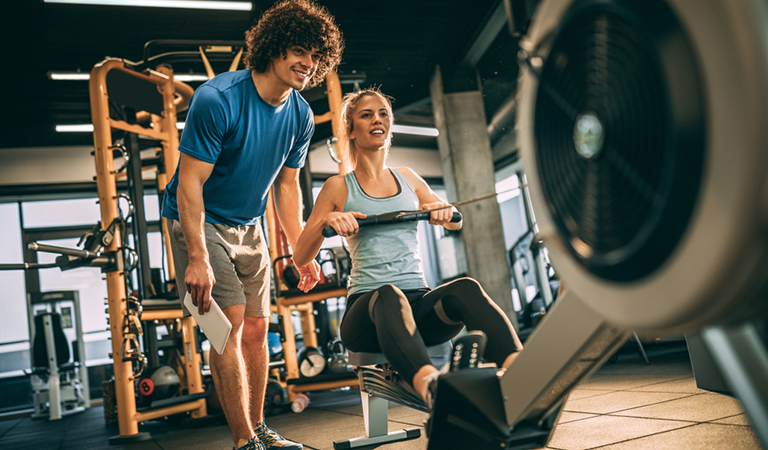
Unlike a spin or a recumbent exercise bike, a rowing machine is one of the hardest machines to use correctly for a great cardio workout. It is easy and intuitive to use a bike or treadmill. But if you go down to your local gym and take a look at people using the rowing machines, you will probably find someone with poor technique. Not only does this compromise your workout, but it could also cause you injury, so knowing the basic techniques is really important. There are different parts of a rowing machine workout, as you aren’t doing the same motion the whole time, like when running or cycling. There are four different parts to the workout, each of which works and trains different muscle groups.
- The catch – This is the first move where you grab the handle of the rowing machine and bend over forward.
- The drive – This is the second move where you start to drive the machine and begin to pull the handle out as you extend your legs back.
- The pull – This is the third move where you pull the handle fully backwards using your full strength.
- Extending – This is the final move where you reach the maximum stretch you can and stretch your back and legs totally out, before recovering and returning to the catch position.
Which Muscle Groups Are Worked On?
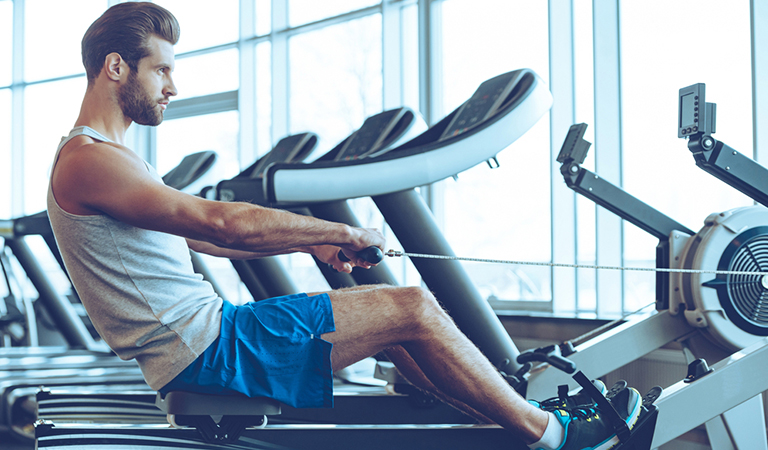
If you are thinking about a rowing machine uses what muscles, then you are not alone. Actually, one of the main benefits of using a rowing machine is that it works lots of different muscles groups. With a rowing machine, the muscle gain rate is improved. Many more than any other type of cardio equipment. It does this because it is a coordinated muscle action that needs all of the large muscle groups in order to achieve the motion. To achieve the most from a rowing machine workout it needs to be a smooth motion that is repeated. Each element of the rowing machine workout will focus on different muscles, and you will find that various rowing machine muscles are targeted.
The catch
The catch is where you grab the handle evenly with both of your hands and have the seat slid right forwards so you are close to the statistics monitor. Your knees should be tucked right into your chest. At this first position, your legs are bent together and your shins are vertical. This means you are working on your Gastrocnemius and Soleus, which are muscles in the back of your legs, as well as your hamstrings, which are the tendons in the back of your knee. At this point, your arms are also extended out, which means your triceps are also getting a good workout. Your lower back muscles (Erector Spinae) get a slight workout, and your abdominals are also slightly flexed as your torso is leaning forward.
The drive
At this point of using your rowing machine, you should press against the footholds until your legs become extended, but not fully extended or locked out. You should be pulling your arms towards your abdomen with your body at a 90-degree angle to the handle. With this second element, the initial motion is driven by your legs. This means you are really working your Gastrocnemius and Soleus, as well as your Hamstrings. At this first point, your shoulder muscles will also contract, working your Rhomboids with your upper back muscles. As you continue with this move, your biceps will work as you pull the handle forward, your Erector Spinae engages as you open your torso and you also work your Quadriceps (Top Thigh Muscles).
The pull
At this point, as you are really pulling the handle backwards you are working on most of the key muscles, including the Erector Spinae, Rhomboids, Hamstrings, Gastrocnemius and Soleus and Quadriceps. You are also giving your Rectus Abdominus or your Stomach Muscles a good workout, as they stabilize your body. At this point as you are really working on the arm pull through, nearly all of your upper body muscles will be working, in particular your Triceps (Bottom Muscles of Upper Arms), Deltoids (Muscles on the joint between arm and shoulder), Trapezius (Upper shoulder muscles), Pectoralis Major (Chest Muscles and Wrist Extensors) and finally your Flexors (Forearm Muscles).
Extending
This final element is all about fully extending your legs out and leaning your body back slightly beyond the 90-degree point. As you complete this final move you are really extending the machine completely, to its and your maximum level. So at this point, you are working on almost all of the muscle groups, except your Trapezius. However, at this point, you are adding in a workout for your External Obliques or Side Abdomen Muscles. Essentially at this point, your lower body muscles and gluten are contracting, as are many of your upper body muscles, to help keep your body in the final finish position. Then, as you recover and move back to the first catch position your triceps push your arms forward and away from your body. Your abdominal muscles will also work to push your body forward and your hamstrings and calves will also contract as you finish in the catch position, ready to go again!
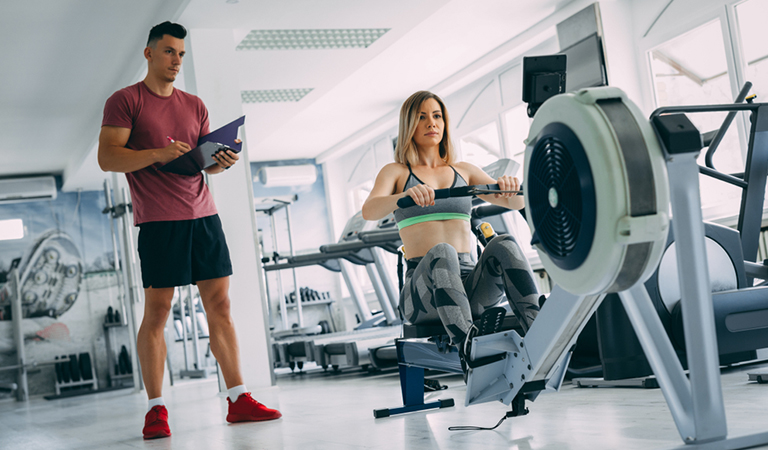
Finally, rowing machines are the unsung heroes of the gym! If you are asking yourself ‘rowing machine uses what muscles?’ the answer is ‘all of them’! They are one of the best ways to get a full body cardio workout on just one machine. That is why they are one of the best investments if you are looking for an upper and lower body workout. As you’ve read from, rowing machine s really do work almost all of our main muscle groups except for our facial muscles. This means you get a great full body workout. They are much better than treadmills or exercise bikes which only work on the lower body, they are better than ellipticals which are good for full body workouts, but don’t work you nearly as hard as a working machine and they don’t build muscle. A rowing machine works all of your muscle groups, so is the most efficient piece of gym equipment to get that all-over cardio workout. So if you are looking to increase your muscles, then get out and row right away!


